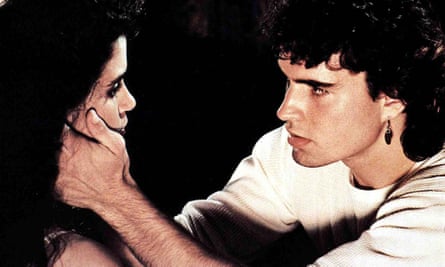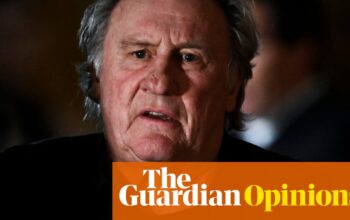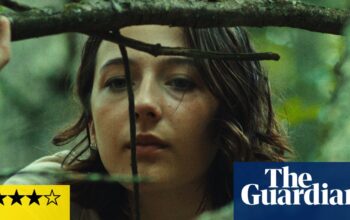Jason Patric, played Michael
Joel Schumacher, the director, wanted me in the movie right from the first time we met. But the script I read was nothing like the magical movie it would become after rewrites and production, and I had no interest in teenage vampire films. So I turned it down about five times – but Joel was determined. He spent weeks explaining his vision, a mix of horror and comedy, and eventually wore me down. We made a deal: he promised I wouldn’t have to wear the makeup, the teeth or have to fly around. Of course, he lied.
All these great people signed up: Dianne Wiest, who was about to win an Oscar for Hannah and Her Sisters, Edward Herrmann, Barnard Hughes, Kiefer Sutherland, Corey Haim and Corey Feldman. It was being shot by Michael Chapman, the cinematographer on Taxi Driver and Raging Bull. I had worked with Jami Gertz and put her forward to play Star. The role had been conceived of as a blond, waifish girl; I told Joel she could bring a sexy, darker quality to the film.
We shot in Santa Cruz, California, for about a month. In the late 70s it was the murder capital of the world and had a bad reputation. The excitement of the boardwalk and homelessness across the city merged to create a creepy, carnival quality, like you might find a freak show around every corner.
I’d seen Corey (Haim) in Lucas. He was a big talent and had this open, affable personality. We read together for the part of my brother Sam and I told Joel: “That’s the guy.” He’d come over to my house and we’d play baseball and go to the pier, which created an unsaid physicality. We had a close bond and he was wonderfully imaginative in an improvisational way. We played off each other.

Joel and I thought my character Michael should be the centre of the film and hold the fantasy, family and sexual elements together. This kid is an outsider, he’s about to become a man and has to leave the family and he gets involved in this group that seems sexy and dangerous. It’s a drug analogy: he drinks the blood and there’s something addictive about it. His personality begins to change and there are things going on he doesn’t understand.
In part, Joel was the classic cliche of a screaming and authoritarian director, but he was also a great listener, and gave the young actors the freedom to create their characters. There wasn’t a scene with Corey where we didn’t discuss how to develop their relationship. It was the John Hughes era, when kids were the stars and not just supporting parts: the entire business paradigm shifted in the mid-80s.
The iconic scene where we’re hanging from a bridge was shot through the night on a real trestle near LA. We were about 100 feet up with a platform underneath us and the stage below was filled with smoke to create the fog clouds we fell through. It was exhausting.
The Lost Boys has become The Wizard of Oz of horror movies – it’s something that completely holds up today and that people watch every year. They feel a sense of kinship because it’s about the idea of teen alienation.
James Jeremias, writer
I grew up in the San Fernando Valley and worked at Warner Bros as a grip on films including Blade Runner and Dead Men Don’t Wear Plaid. Janice Fischer and I had met studying cinema together in LA, we wrote the script for The Lost Boys in about five months during 1984. We bought Syd Field’s book Screenplay: The Foundations of Screenwriting and drew a paradigm of our story across his three-act structure.
after newsletter promotion
I’d read Interview With the Vampire by Anne Rice and was inspired by the little girl, Claudia, trapped in the body of a five-year-old for eternity. It got me thinking about JM Barrie’s Peter Pan – where our title came from. What if the reason he came out at night, could fly and didn’t grow up was because he was a vampire? We took a fictional character and put him in a new light. What if it wasn’t all goodness and there was some evil intent?
Warner Bros paid us $375,000 for the script. About a year later, we had a meeting with [original director, later executive producer] Richard Donner about rewrites. It was brutal. We had designed the film to be a boy’s adventure, set in a time before sex rears its head. But that’s not what the studio wanted. Donner wanted the boys to be old enough to drive. What he meant was old enough to fuck. He also wanted Star – whom we’d written as a boy – to change sex and be the love interest. He was turning our story into a teenage vampire movie. Once we sold the script it was out of our hands.
During filming, I went down to the Warner Bros lot. I was told it was a closed set and was asked to leave. But I was invited to the official cast and crew screening when it came out in 1987. I remember marvelling at it being the culmination of me sitting on my couch, smoking a joint and dreaming up this idea. The script had gone through a lot of changes but our story was still there.
Source: theguardian.com


